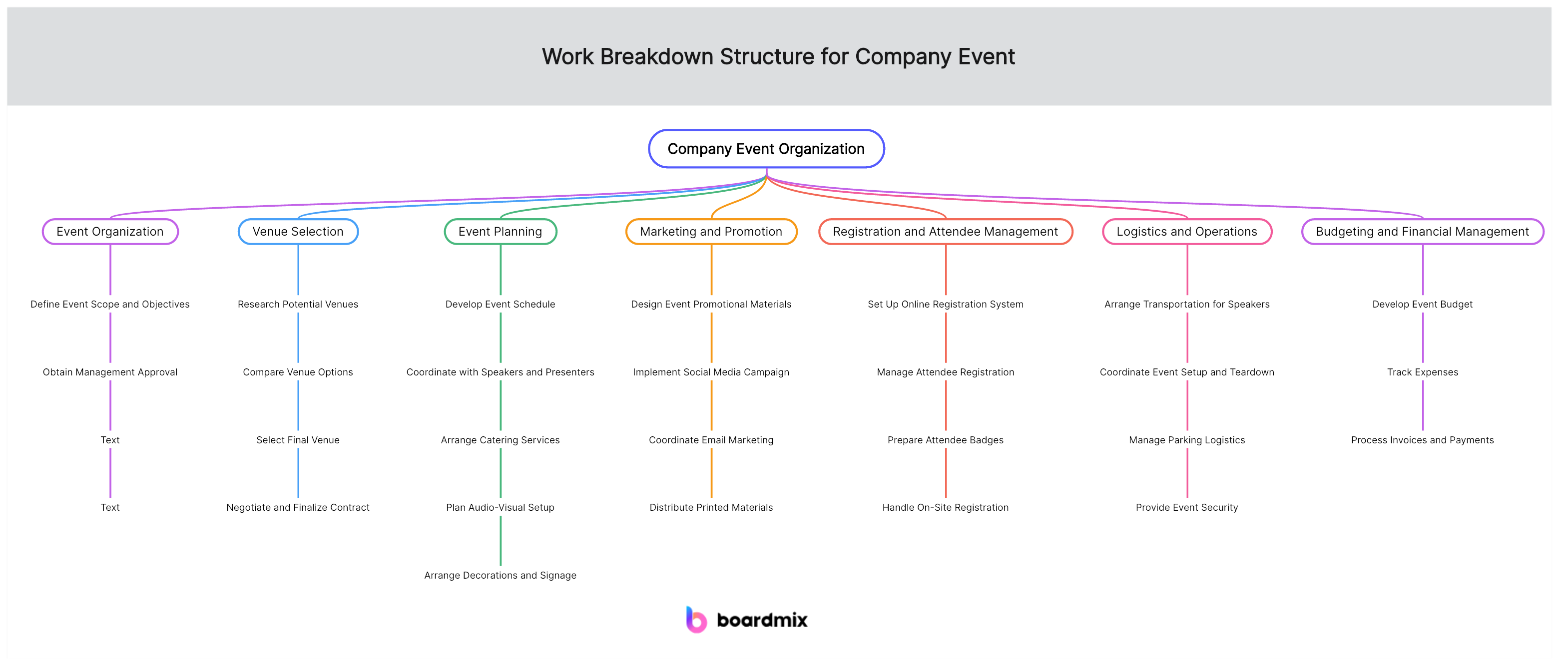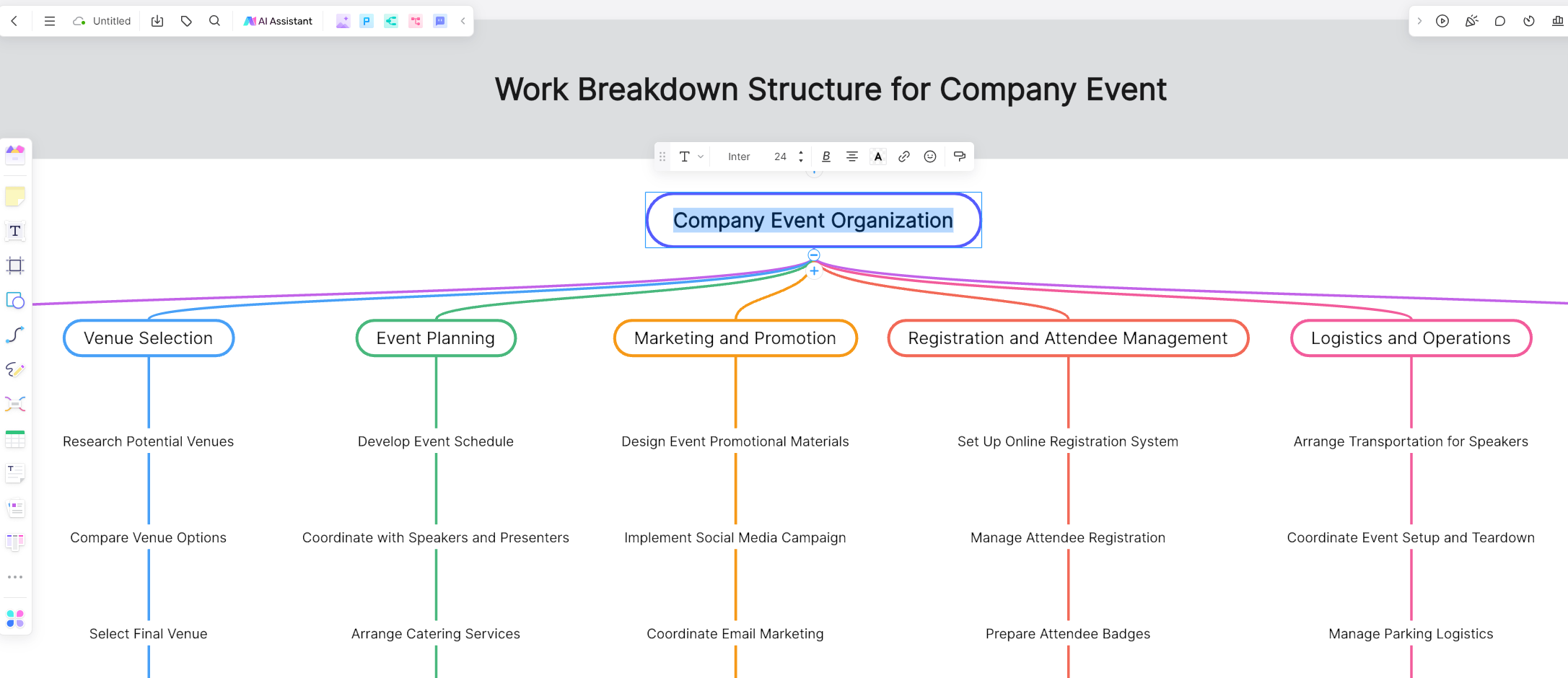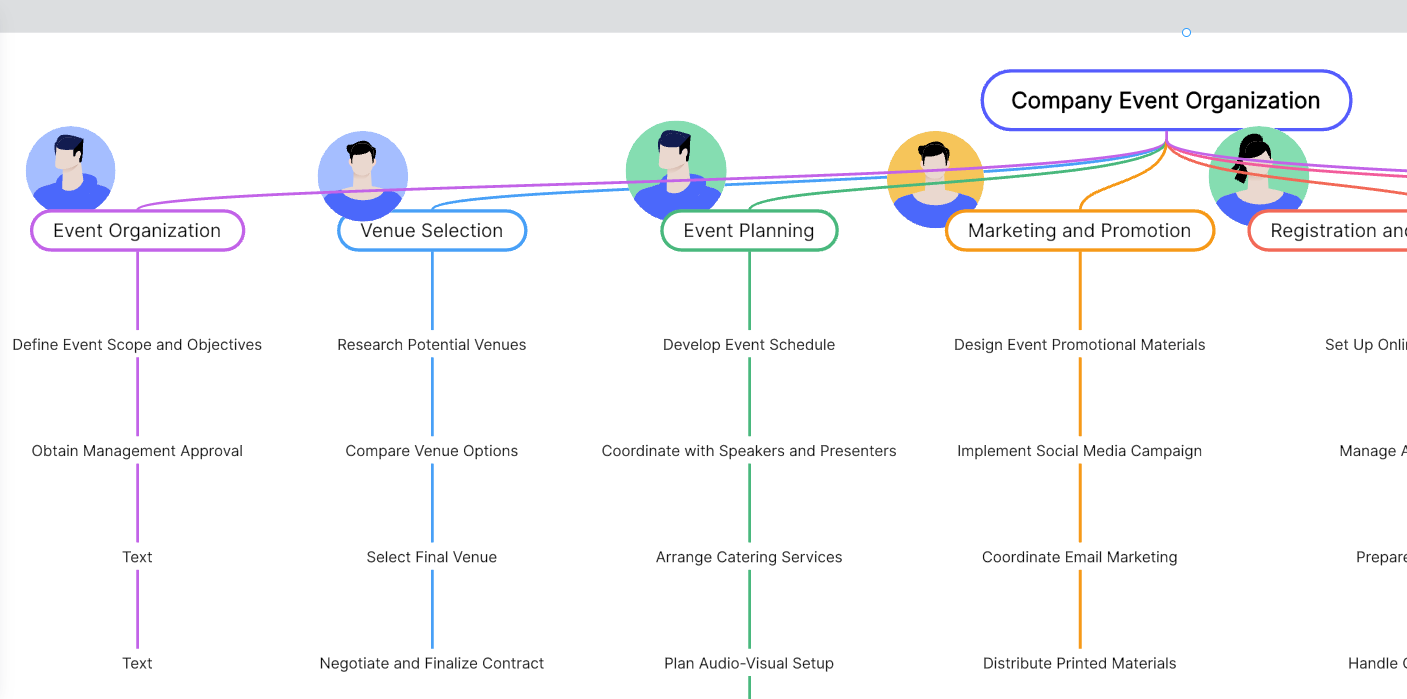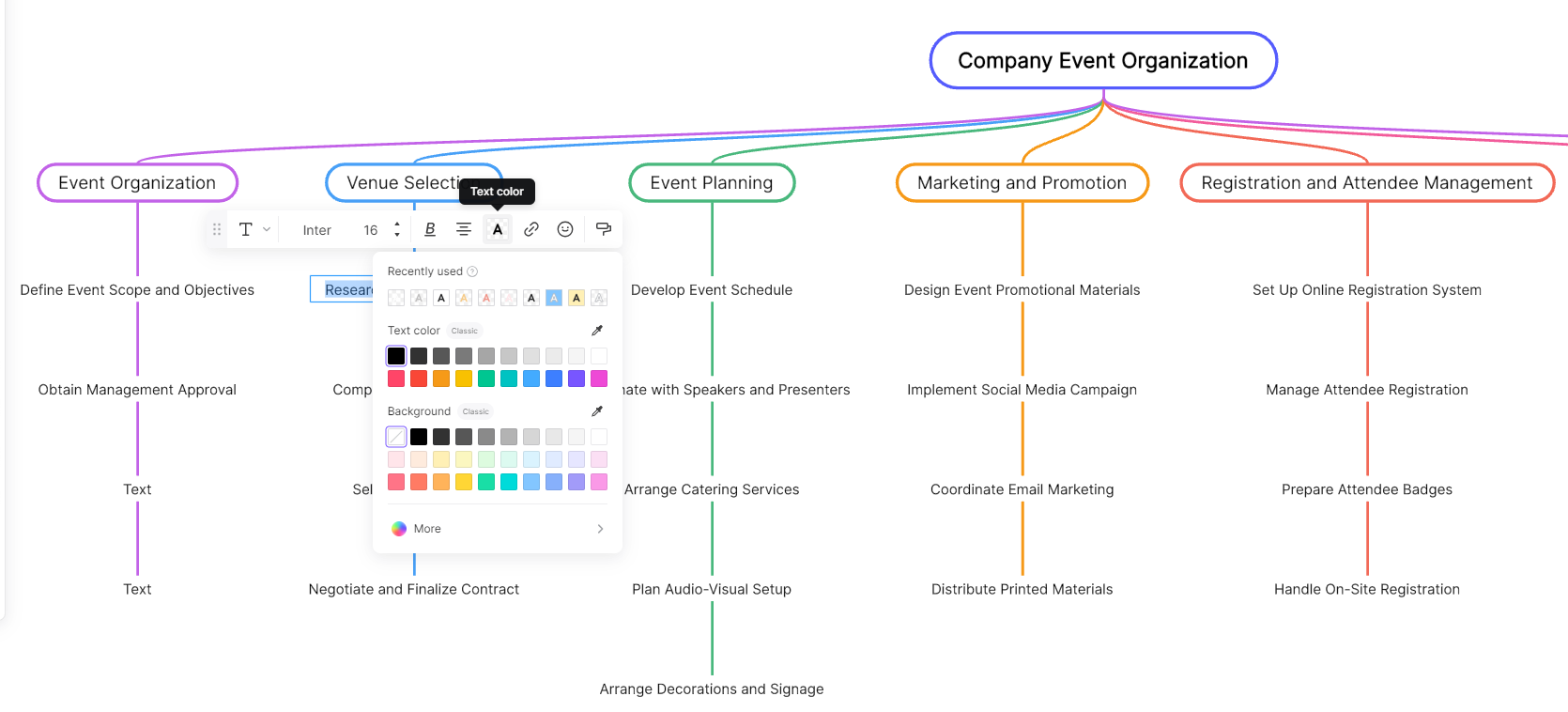A Work Breakdown Structure (WBS) is a fundamental tool in project management, offering a systematic approach to breaking down complex projects into manageable components. It provides a visual representation of the project's scope and structure, facilitating effective planning, execution, and control. In this comprehensive guide, we will explore what a WBS is, how to create a work breakdown structure, and best practices, and provide examples to illustrate its practical application.

Part 1. What is a Work Breakdown Structure (WBS)?
A Work Breakdown Structure is a hierarchical decomposition of the total scope of work to be carried out by the project team. It organizes and defines the total scope of the project, breaking it down into smaller, more manageable components. These components can be further broken down into individual tasks, creating a clear and structured roadmap for project execution.
Part 2. How to Create a Work Breakdown Structure
Creating a Work Breakdown Structure (WBS) is a crucial step in project management. A WBS helps break down a project into smaller, more manageable components, making it easier to plan, execute, and monitor. Here's a step-by-step guide on how to create a Work Breakdown Structure in seven steps:
1. Define Project Scope
Clearly articulate the project's objectives and deliverables.
Understand the project's boundaries and what is included and excluded.
2. Identify Major Deliverables
List all the significant outcomes or products that the project will produce.
These are the tangible results that contribute to achieving the project's objectives.
3. Break Down Major Deliverables
For each major deliverable, break them down into smaller, more manageable tasks or sub-deliverables.
Use a hierarchical structure to organize these components.
4. Keep Breaking Down
Continue breaking down each sub-deliverable into smaller tasks until you reach a level where the tasks are easily manageable and can be assigned to a specific team member.
Use the "divide and conquer" approach to decompose work into smaller, more understandable pieces.
5. Use a Hierarchical Structure
Organize the tasks in a hierarchical manner, starting with the top-level major deliverables and drilling down to the smallest tasks.
Typically, a WBS is represented as a tree diagram with branches representing major deliverables and sub-deliverables.
6. Assign Codes and Identifiers
Assign unique codes or identifiers to each element in the WBS to facilitate tracking and referencing.
Codes should reflect the hierarchical structure, making it easy to navigate and understand the breakdown.
7. Review and Validate
Review the WBS with key stakeholders to ensure that all necessary tasks are included and that there is a common understanding of the project's structure.
Validate the WBS against the project scope to ensure alignment with project objectives.
Remember that a WBS is a dynamic tool that may need to be revised as the project progresses and more details become available. It provides a solid foundation for project planning, resource allocation, and monitoring progress throughout the project lifecycle. Regularly update and communicate changes to ensure everyone involved in the project is on the same page.
Part 3. Best Practices for Creating a Work Breakdown Structure
Creating an effective Work Breakdown Structure (WBS) is crucial for successful project management. Here are some best practices to consider when developing a WBS:
Involve Key Stakeholders:
- Include input from project team members and relevant stakeholders when developing the WBS.
- Ensure that everyone has a shared understanding of the project scope and objectives.
Start with the End in Mind:
- Begin by identifying the major deliverables and outcomes that the project aims to achieve.
- Break down these major deliverables into smaller, more manageable components.
Use a Hierarchical Structure:
- Organize the WBS in a hierarchical manner, with higher levels representing major deliverables and lower levels representing detailed tasks.
- This structure provides a clear visual representation of the project's scope and breakdown.
Keep It Manageable:
- Avoid creating overly detailed WBS elements. Tasks should be small enough to manage but not so granular that they become insignificant.
- Find a balance that allows for effective project control without overwhelming the team with excessive detail.
Use Consistent WBS Coding:
- Assign unique codes or identifiers to each WBS element.
- Consistent coding helps with organization, tracking, and referencing throughout the project lifecycle.
Validate Against Project Scope:
- Regularly review and validate the WBS against the project scope to ensure alignment.
- Confirm that all necessary tasks are included and that the WBS accurately reflects the project's objectives.
Consider the 100% Rule:
- The WBS should represent 100% of the project's scope. No work should be left out or duplicated in different parts of the WBS.
- This ensures that all aspects of the project are covered.
Part 4. Example of Work Breakdown Structure
Let's consider a simple project to organize a company event. The WBS for this project can be broken down into major deliverables, sub-deliverables, and tasks. Here's an example:

Work Breakdown Structure (WBS) for Company Event
Project: Organize Company Event
1.1 Define Event Scope and Objectives
1.2 Obtain Management Approval
Venue Selection
2.1 Research Potential Venues
2.2 Compare Venue Options
2.3 Select Final Venue
2.4 Negotiate and Finalize Contract
Event Planning
3.1 Develop Event Schedule
3.2 Coordinate with Speakers and Presenters
3.3 Arrange Catering Services
3.4 Plan Audio-Visual Setup
3.5 Arrange Decorations and Signage
Marketing and Promotion
4.1 Design Event Promotional Materials
4.2 Implement Social Media Campaign
4.3 Coordinate Email Marketing
4.4 Distribute Printed Materials
Registration and Attendee Management
5.1 Set Up Online Registration System
5.2 Manage Attendee Registration
5.3 Prepare Attendee Badges
5.4 Handle On-Site Registration
Logistics and Operations
6.1 Arrange Transportation for Speakers
6.2 Coordinate Event Setup and Teardown
6.3 Manage Parking Logistics
6.4 Provide Event Security
Budgeting and Financial Management
7.1 Develop Event Budget
7.2 Track Expenses
7.3 Process Invoices and Payments
This WBS breaks down the project into major components, such as Project Initialization, Venue Selection, Event Planning, Marketing, Registration, Logistics, Budgeting, and Post-Event Activities. Each major component is then further divided into specific tasks and sub-tasks. The hierarchical structure helps in organizing and understanding the project's scope in a systematic way.
Part 5. How to Create a Work Breakdown Structure with Templates in Boardmix
Boardmix is an innovative online whiteboard tool designed to streamline the process of creating a Work Breakdown Structure (WBS). With our extensive range of drawing templates, you can easily break down your projects into manageable tasks and subtasks. Boardmix allows you to visualize the hierarchy of tasks, assign responsibilities, and track progress all in one place. Unlike traditional methods, using Boardmix for your WBS not only saves time but also enhances collaboration among team members. Start simplifying your project management with Boardmix today.

How to create a work breakdown structure in Boardmix
1. Start a new board: Log into your Boardmix account and click on 'Create New Board'. Choose the 'Work Breakdown Structure' template from our extensive collection.

2. Define your project: At the top of your WBS, write down the name of your project. This will be the highest level of your structure.

3. Break down your project: Start breaking down your project into main tasks or deliverables, then break these down further into subtasks. You can do this by adding boxes or nodes under each task.

4. Assign responsibilities: For each task or subtask, assign a team member responsible for its completion.

5. Track progress: Use color codes or markers to track the progress of each task and subtask.

Conclusion
A well-crafted Work Breakdown Structure is an indispensable tool for project managers, providing a roadmap for successful project execution. By following the steps outlined in this comprehensive guide, incorporating best practices, and referencing practical examples, project teams can create a WBS that enhances communication, facilitates resource allocation, and ensures project success, regardless of complexity or scale.
Boardmix is the ultimate tool for creating a Work Breakdown Structure, offering an intuitive interface and a wide range of templates to simplify your project management. With Boardmix, you can easily visualize tasks, assign responsibilities, and track progress in real-time. Don't miss out on this opportunity to enhance collaboration and efficiency in your team - start using Boardmix today.













